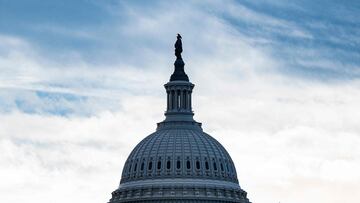What is the history of the US debt ceiling and why does it matter?
The debt ceiling marks the upper limit of total national debt and has been raised countless times over the last century by both parties to avoid a default.


On Tuesday evening the Senate voted to raise the federal government debt limit by $2.5 trillion, a measure which removes the imminent threat of a historic first default on the national debt.
The Treasury had warned that unless a solution could be found the country may become unable to cover its financial obligations as early as 15 December, after the expiration of a debt ceiling suspension enacted during the Trump presidency.
The bill was passed using a new Senate mechanism which allows a debt ceiling increase to be approved with just a simple majority and avoid the filibuster. The increase takes the debt ceiling top threshold to $31.4 trillion, a figure that is expected to suffice until 2023 at the earliest.
Senate Democrats on Tuesday voted to raise the debt ceiling, bypassing a GOP filibuster as part of a deal struck by congressional leaders. Senators voted 50-49 along party lines to raise the debt ceiling by $2.5 trillion. https://t.co/Cve7j35Nok pic.twitter.com/CW4AcdlkTW
— The Hill (@thehill) December 15, 2021
The history of the debt ceiling in the United States
The national debt ceiling was first introduced in 1917 when Congress passed the Second Liberty Bond Act, providing a formal limit on the amount of debt that the government could assume. Debt was issued in the form of government bonds which could be sold off to raise funds.
The level of public debt has fluctuated ever since but has always remained beneath the upper threshold, preventing a default on those debts. In the 20th century alone the debt ceiling was raised more than 90 times and has never been lowered.
President Ronald Reagan raised the limit 18 times; while President Bill Clinton did so eight times. Since 2001 the debt ceiling had been raised 14 times, with another coming imminently once the House passes the latest iteration and President Biden signs it into law.
In 2008, at the time of the Great Recession, the total public debt stood at $9.65 trillion. That figure will rise to $31.4 trillion when the new increase is enacted. Democrats in Congress have reiterated the vital importance of avoiding a debt default and ensuring that the debt accrued by both parties is covered.
Trump utilised a debt ceiling suspension to avoid default
Raising the debt ceiling has been done countless times in the last century, but it is also possible to avoid a catastrophic default by enacting a suspension of the limit. This is what happened in 2019 when President Trump signed a bill suspending the debt ceiling until July 2021, a measure which was then extended until December.
Related stories
When Trump came to power the national debt was at $19 trillion and he promised to completely eliminate the debt over an eight-year period. However the passage of a $1.5 trillion tax cut package in 2017 and increased federal spending meant that it reached $22 trillion halfway through his single term in office.
Shortly after the 2021 debt ceiling increase was approved by the Senate, Sen. Chuck Schumer said that the decision taken was "about paying debt accumulated by both parties."
.@SenSchumer: "The resolution we will vote on will provide for raising of the debt limit to a level commensurate with funding necessary to get into 2023. As I have said repeatedly, this is about paying debt accumulated by both parties." https://t.co/FACMC3Ox3r pic.twitter.com/evHmPmI0Of
— The Hill (@thehill) December 15, 2021

